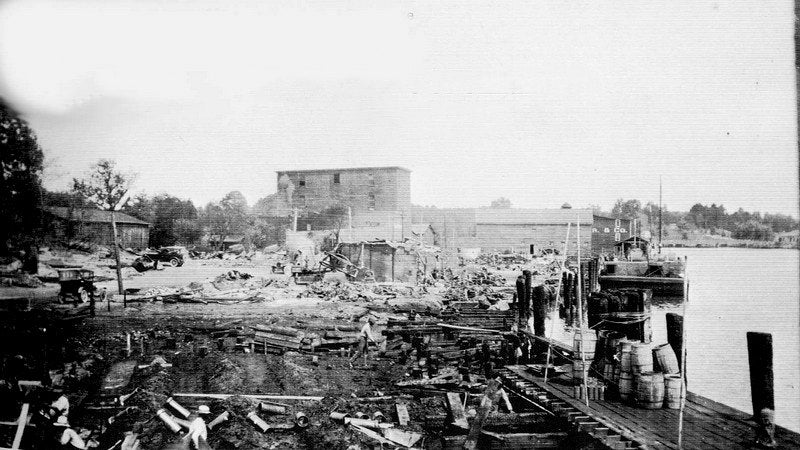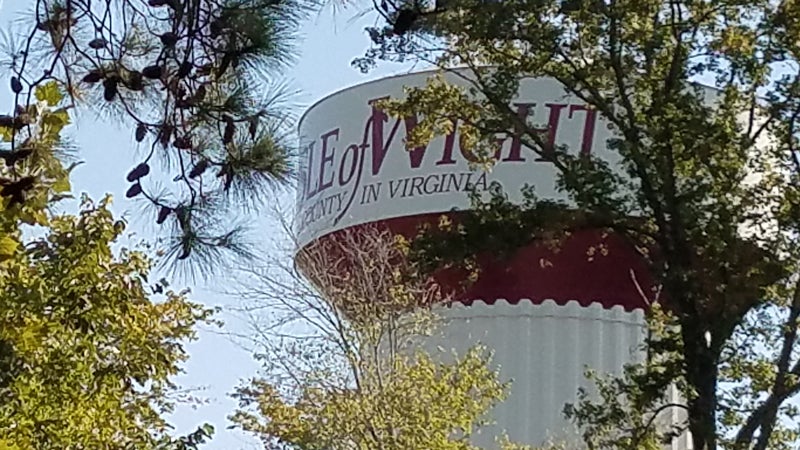From peanuts to hams
Published 7:00 pm Tuesday, August 17, 2021

- This 1921 photo shows the devastation wrought by the Aug. 17, 1921, fire along Smithfield’s wharf. (Submitted Photo)
How the 1921 Great Fire changed Smithfield
“Peanut industry of Smithfield is wiped out by fire.”
That was the headline that ran in the Aug. 18, 1921, edition of the Richmond Times-Dispatch the day after a blaze burned through two blocks of Commerce Street, destroying the old Gwaltney-Bunkley peanut factory and a number of warehouses.
But was the fire truly the cause of death for Smithfield’s days as the self-proclaimed “peanut capital of the world,” or was it merely the final nail in the coffin?
Smithfield, according to Patrick Evans-Hylton’s book, “Smithfield: Ham Capital of the World,” began as a shipping port in the early days of the 18th century, when Commerce Street consisted of a footpath leading to a public landing on the Pagan River. In 1779, Mallory Todd began shipping Smithfield hams from the site.
The town continued to conduct much of its commerce by water nearly a century later when Pembroke D. Gwaltney Sr., a Confederate veteran of the Civil War, “returned to his farm, penniless, from the surrender at Appomattox Court House” and “laid aside his ragged gray jacket, and took up the culture of peanuts,” writes Helen Gray in a Feb. 6, 1902, Leslie’s Weekly interview with the “Peanut King,” as Gwaltney was then known.
According to Helen Haverty King’s “Historical Notes on Isle of Wight County, Virginia,” Gwaltney had initially partnered with his cousin, O.G. Delk, to erect a smokehouse behind their store and warehouse on Commerce Street, using Delk’s sloop, named the “Three Sisters,” to transport items via the Pagan River. Gwaltney bought out Delk’s interest in 1875 and erected his first peanut cleaning plant on Commerce Street in 1880, which utilized machinery, some of which Gwaltney had designed himself.
In 1891, the Gwaltney-Bunkley Peanut Company incorporated, naming P.D. Sr. as its president. Then, in 1897, Gwaltney bought out the Independent Peanut Company of Smithfield, gaining possession of a four-story building capable of generating its own electricity.
As of 1902, Gwaltney’s factory employed about 300 workers, most of whom were Black men and girls “from fifteen and up,” according to Gray, and was processing about 300,000 bags of cleaned peanuts a year, equating to about $1.25 million ($39.6 million in today’s dollars).
Gray described Gwaltney as belonging to “the progressive type of Southerners,” his hand “ever extended toward those less fortunate than himself,” but also notes there had been a strike among his workers about two years prior that had lasted 10 days “at the end of which time they quietly resumed work at the same wages, from forty cents to one dollar and twenty five cents a day.”
“When there is a full force they are encouraged to sing Moody and Sankey hymns and plantation melodies, the management saying they are more attentive to their work when singing,” Gray wrote.
By 1911, Gwaltney-Bunkley had sold out to the American Peanut Corporation, “So when the big fire came to Smithfield on the morning of August 17, 1921, the Gwaltneys lost very little; it was the American Peanut Corporation which lost its business in Smithfield,” King writes. “Fortunately, they were covered by insurance.”
P.D. Sr. himself had died six years before the fire, in 1915.
“P.D. Gwaltney, Jr., and F.R. Berryman [a business associate of P.D. Sr.] must have seen the handwriting on the wall as far as the peanut industry in Smithfield was concerned,” King writes. “Although Amedeo Obici’s Planters Nut and Chocolate Company had not yet moved to Suffolk, they were looking the situation over carefully and had bought a small factory there in 1913. Then, too, Smithfield lacked a railroad and Suffolk had a great network of tracks. Perhaps P.D., Jr., saw his family’s future in the meat business, in which he had already become well established.”
On April 6, 1920, just over a year before the Great Fire, the Old Dominion Steamship Company suddenly ceased servicing Smithfield, which a Virginian-Pilot article from that date blamed on increasing demands from organized labor. It was projected at the time that the end of the steamship line would keep $2 million ($27.6 million in today’s dollars) worth of produce from going to market. According to King, the businessmen of Smithfield and farmers of northern Isle of Wight County raised enough money to buy the steamship Hampton Roads and the wharf, employing Capt. Albert Gard, who had made the Norfolk-to-Smithfield run for the Old Dominion shipping line. The new steamship company became known as the Smithfield, Newport News and Norfolk Steamship Co.
When the Great Fire destroyed Smithfield’s docks the next year, the town could no longer compete with the emerging peanut market in Suffolk.
William Henry Sykes Jr., a 12-year-old boy at the time of the fire, wrote in 1988 that when one of the peanut factories and warehouses burned, it “produced a large quantity of black peanut oil that floated all over the river, onto every boat hull and mooring line. The rise and fall of the tide painted the marsh grass an ugly black which remained for more than two years.”
Given Smithfield’s dependence at the time on the Pagan River for commerce, its docks were among the first structures to be rebuilt, but by that time “Suffolk had gotten into the act [of mass-producing peanuts],” Sykes writes. “They had railroads; we had none and that made the difference.”
Smithfield’s days as a river port continued a few more years. The James Adams Floating Theater, which served as the inspiration for Edna Ferber’s 1926 novel “Show Boat” and the Broadway musical by the same name, used to stop in Smithfield. No one knew at the time of the fire that just seven years later, the James River Bridge would change the whole pattern of life on the south side of the river, Sykes writes.
“It was just a changing evolution of things,” said Isle of Wight County Museum Director Jennifer England.
About a year after the fire, P.D. Jr. discovered a smoked ham that had been hanging, undisturbed, in the rafters of one of his smokehouses for 20 years. He fashioned a brass collar for it, calling it his “pet” ham, and began taking the ham on tour as a demonstration of the preserving powers of his curing method — cementing his family’s, and the town’s, transition from peanuts to hams.





